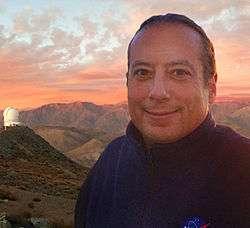Paul Kalas
Paul Kalas (born August 13, 1967) is a Greek American astronomer known for his discoveries of debris disks around stars. Kalas led a team of scientists to obtain the first visible-light images of an extrasolar planet with orbital motion around the star Fomalhaut, at a distance of 25 light years from Earth.[1] [2] The planet is referred to as Fomalhaut b.
Paul Kalas | |
|---|---|
 Paul Kalas in 2015, Cerro Pachón, Chile | |
| Born | August 13, 1967 |
| Nationality | Greek American |
| Citizenship | United States of America |
| Alma mater | University of Hawaii University of Michigan, Ann Arbor |
| Known for | Exoplanet Research Fomalhaut, Fomalhaut b |
| Awards | Newcomb Cleveland Prize (2009) |
| Scientific career | |
| Fields | Astronomy |
| Institutions | University of California, Berkeley |
| Doctoral advisor | David Jewitt |
Background
Kalas was born in New York City to George Kavallinis and Maria Drettakis, who immigrated to the United States from Heraklion, Crete. Kalas attended Detroit Country Day School in Michigan, and studied astronomy and physics at the University of Michigan, Ann Arbor. He earned a Ph.D. in Astronomy in 1996 from the University of Hawaii under the direction of astronomer David Jewitt.
Kalas worked as a postdoctoral scientist at the Max Planck Institute for Astronomy in Heidelberg, Germany, the Space Telescope Science Institute, and the University of California, Berkeley. In 2006, he became an Adjunct Professor of Astronomy at the University of California, Berkeley.
Kalas lives with his wife Aspasia Gkika and daughters Maria-Nikoleta and Natalia near Berkeley, California.[3]
Discoveries
Kalas discovered several circumstellar disks using a coronagraph on the Hubble Space Telescope and at the University of Hawaii 2.2-meter telescope at Mauna Kea, Hawaii. In 1995 he discovered various forms of asymmetric structures in optical images of the Beta Pictoris disk.[4] He was the lead scientist for the first optical images of debris disks surrounding the nearby red dwarf AU Microscopii and the bright star Fomalhaut.[5][6]
Kalas' Hubble Space Telescope image of Fomalhaut revealed a narrow belt of dusty material analogous to our Solar System's Kuiper Belt. However, Kalas also found that Fomalhaut's belt is narrow and geometrically offset from the star by 15 astronomical units. These features are considered strong evidence for an extrasolar planet orbiting Fomalhaut that gravitationally sculpts the morphology of the belt.
| AU Microscopii[6] | October 14, 2003 |
| Fomalhaut[5] | May 17, 2004 |
| HD 15115[7] | July 17, 2006 |
| HD 53143[8] | September 11, 2004 |
| HD 139664[8] | October 14, 2004 |
Honors
- Elected Fellow of the American Association for the Advancement of Science (2014)[9]
- AIAA William H. Pickering Lecture (2010)[10]
- Newcomb Cleveland Prize of the American Association for the Advancement of Science (2009)[11][12]
Selected publications
Articles
- Kalas, P.; Liu, M.C. & Matthews, B.C. (2004). "Discovery of a large dust disk around the nearby star AU Microscopii". Science. 303 (5666): 1990–1992. arXiv:astro-ph/0403132. Bibcode:2004Sci...303.1990K. doi:10.1126/science.1093420. PMID 14988511.
- Kalas, P.; Graham, J.R. & Clampin, M. (2005). "A planetary system as the origin of structure in Fomalhaut's dust belt". Nature. 435 (7045): 1067–1070. arXiv:astro-ph/0506574. Bibcode:2005Natur.435.1067K. doi:10.1038/nature03601. PMID 15973402.
- Kalas, Paul; et al. (2008). "Optical Images of an Exosolar Planet 25 Light-Years from Earth". Science. 322 (5906): 1345–1348. arXiv:0811.1994. Bibcode:2008Sci...322.1345K. doi:10.1126/science.1166609. PMID 19008414.
Books
- Kalas, Paul (2018), The Oneironauts: Using dreams to engineer our future’, ISBN 978-1720177616
References
- Overbye, Dennis (November 14, 2008). "First Pictures Taken of Extrasolar Planets". The New York Times. Retrieved 13 November 2008.
- Kalas, Paul; et al. (2008). "Optical Images of an Exosolar Planet 25 Light-Years from Earth". Science. 322 (5906): 1345–1348. arXiv:0811.1994. Bibcode:2008Sci...322.1345K. doi:10.1126/science.1166609. PMID 19008414.
- http://astro.berkeley.edu/~kalas/
- Kalas, P.; Jewitt, D. (1995). "Asymmetries in the Beta Pictoris dust disk". The Astrophysical Journal. 110: 794–804. Bibcode:1995AJ....110..794K. doi:10.1086/117565.
- Kalas, P.; Graham, J.R. & Clampin, M. (2005). "A planetary system as the origin of structure in Fomalhaut's dust belt". Nature. 435 (7045): 1067–1070. arXiv:astro-ph/0506574. Bibcode:2005Natur.435.1067K. doi:10.1038/nature03601. PMID 15973402.
- Kalas, P.; Liu, M.C. & Matthews, B.C. (2004). "Discovery of a large dust disk around the nearby star AU Microscopii". Science. 303 (5666): 1990–1992. arXiv:astro-ph/0403132. Bibcode:2004Sci...303.1990K. doi:10.1126/science.1093420. PMID 14988511.
- Kalas, P.; Fitzgerald, M. & Graham, J.R. (2007). "Discovery of extreme asymmetry in the debris disk surrounding HD 15115". The Astrophysical Journal. 661 (1): L85–L88. arXiv:0704.0645. Bibcode:2007ApJ...661L..85K. doi:10.1086/518652.
- Kalas, P.; Graham, J.R.; Clampin, M.C. & Fitzgerald, M. (2006). "First scattered light images of debris disks around HD 53143 and HD 139664". The Astrophysical Journal. 637 (1): L57–L60. arXiv:astro-ph/0601488. Bibcode:2006ApJ...637L..57K. doi:10.1086/500305.
- Sarah Yang (November 24, 2014). "Four UC Berkeley faculty named AAAS fellows". Retrieved 2015-11-16.
- AIAA Public Release (July 13, 2010). "Space 2010 Conference set for August 30 - Sep. 2 in Anaheim". Retrieved 2015-11-16.
- Robert Sanders (February 18, 2010). "Images of extrasolar planets win award for most outstanding papers in Science". Retrieved 2010-03-11.
- AAAS (November 2009). "Newcomb Cleveland Prize Recipients". Archived from the original on 2012-10-23. Retrieved 2010-04-21.